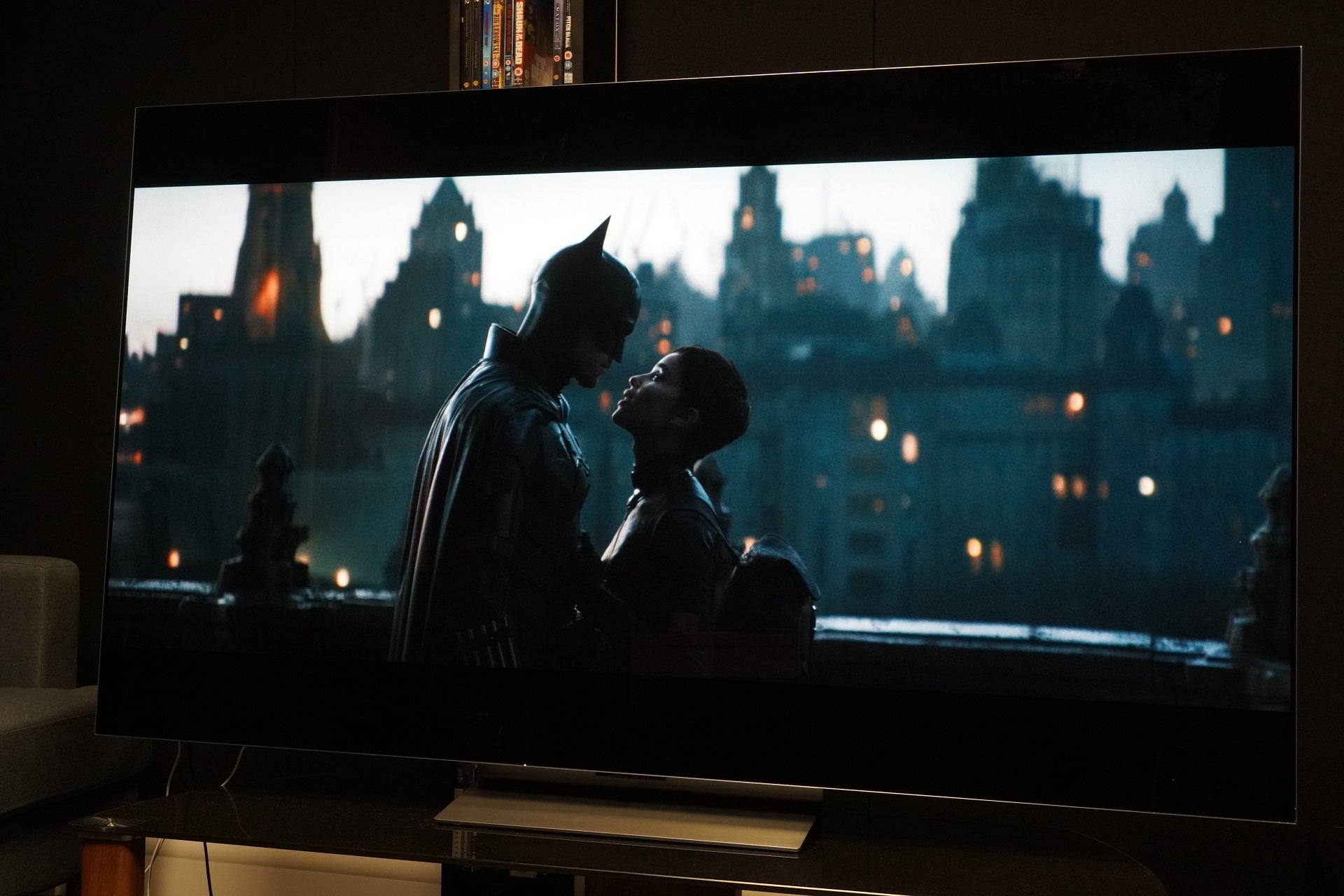Verdict
The G2 is LG’s best OLED, with improvements to its brightness reaping dividends by way of a fantastic HDR performance. Its feature set is extensive, its smart abilities are well implemented; but the cost and focus on wall-mounting mean the C2 OLED is likely to be the more affordable option for most.
Pros
- Excellent HDR performance
- Improved motion skills
- Accommodating gaming features
- Slim design
- Wide selection of streaming apps
Cons
- Higher starting price than G1
- Average audio
- Stand is optional extra
-
ScreenFeatures LG’s new OLED EX panel and Brightness Booster Max technology -
HDRDolby Vision IQ with Precision Detail for exacting Dolby Vision HDR performance
Introduction
OLED has had plenty of detractors, none more so than Samsung. So, there must have been a wry smile across the faces of many at LG when the company’s South Korean adversary launched a QD-OLED rival.
Greater competition hasn’t put LG off its stride, though. The G2 (OLED65G2) is the brand’s top-of-the-line OLED TV, offering improved brightness over the 2021 G1.
LG has been OLED’s biggest cheerleader and the G2 sets out its stall as not just the best 4K TV you can get from the company itself, but potentially the best 4K TV from any manufacturer out there.
Availability
- UKRRP: £3299
- USARRP: $3199
- EuropeRRP: €3599
- CanadaRRP: CA$4999
- AustraliaRRP: AU$5376
The LG G2 OLED model tested is the 65-inch model (OLED65G26LA). It’s also available in a smaller 55-inch model (OLED55G26LA / £2399), a 77-inch (OLED77G26LA / £4499), and the new 83-inch version (OLED83G26LA / £6499).
The 65-inch’s RRP is £3299 / $3199 / €3599 / CA$4999 / AUD$5376. In most markets, the G2’s price has gone up slightly.
Design
- Another elegant, minimalist set
- Wall bracket included as standard
- Stands are optional extras
Like previous Gallery Series OLEDs, the G2 is designed first and foremost with wall-mounting in mind, including wall brackets in the box but no stand.
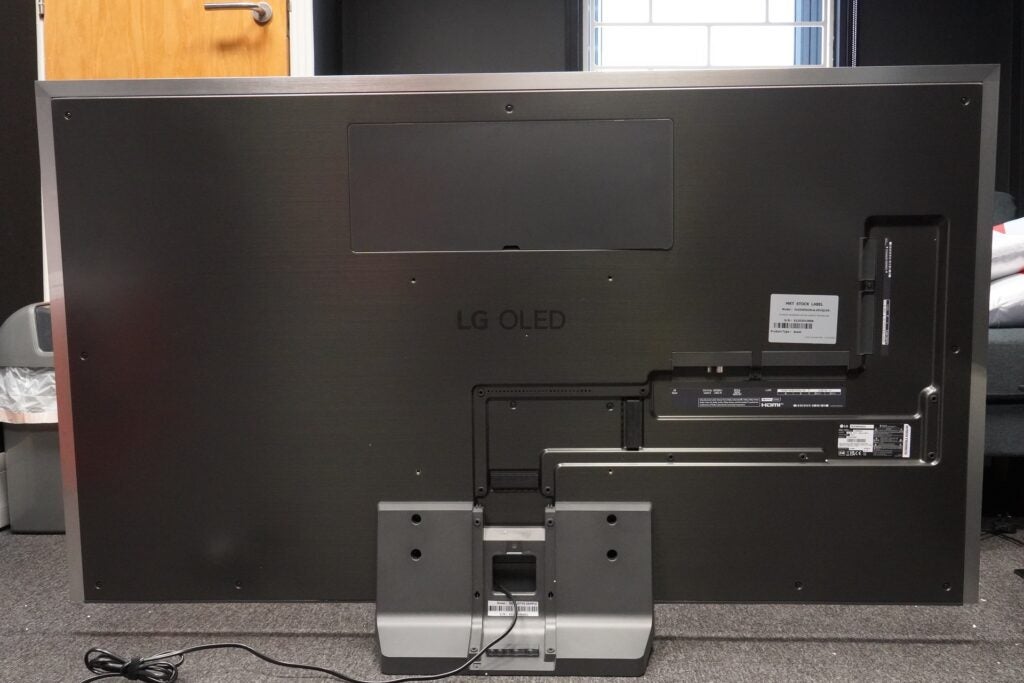
Aesthetically, it’s an elegant and minimalist effort, with the bezel more of frame that encases the screen. The covers for the back panel look slightly less flimsy when applied than they did on the G1, but it isn’t something you’re going to notice once the TV is set up.
The 65-inch G2 is slightly thicker than the G1 (24.3mm compared to 19.9mm). However, the shallow depth of the rear panel allows it to lie almost flush against a wall, while downward and side-facing connections make it easier to plug in devices.
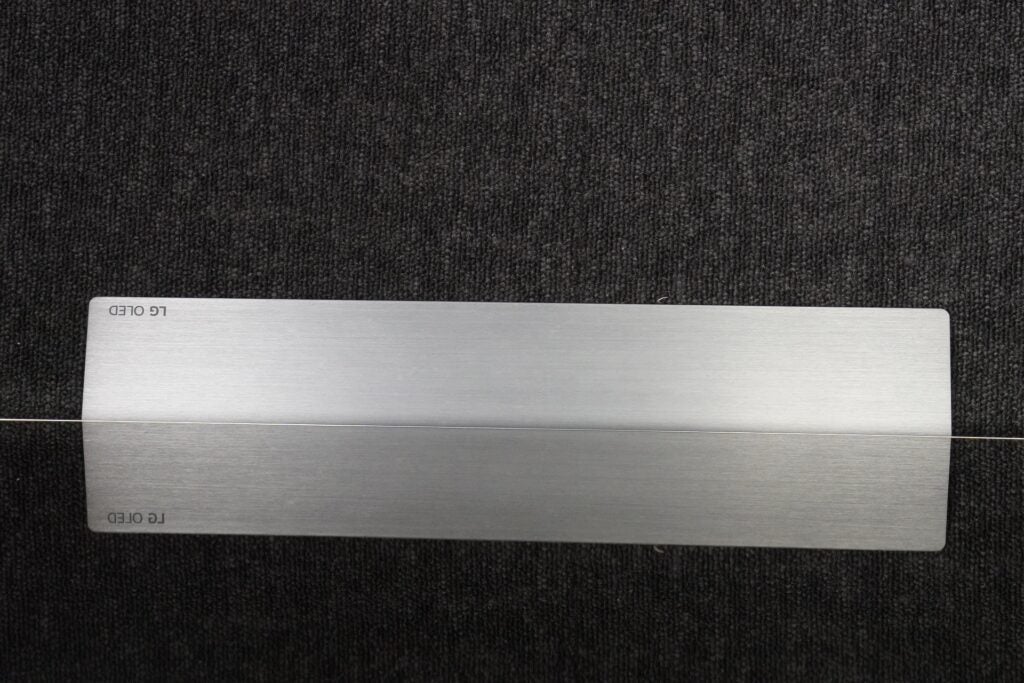
There’s the option of purchasing the Gallery Stand (if you’re putting the TV in a freestanding position) or Swivel Stand, which tilts at an angle of four degrees. The Swivel Stand is easy enough to lock in, featuring an area to thread through cables to keep the setup neat and tidy. With the G2, LG has designed a TV that works in virtually every position it finds itself.
Interface
- Comprehensive SVOD selection
- No major changes to remote/webOS
The webOS interface and remote continue as is from 2021. The top area of the homescreen has been rejigged with the most recent input added (potentially to make you notice the LG Account sign-up area).
Beneath that is the Trending Now bar, app list, a row of physical/digital inputs and smart connections, live TV and Now Streaming; the latter collates content from iPlayer, Apple TV, All 4, YouTube, Rakuten TV and ITV Hub. I prefer this approach over 2021’s webOS, since it’s more focused instead of serving content from every app, which I found overwhelming.
There’s a big number of apps, with the UK catch-up and on-demand apps (along with Freeview Play), Sky Store and Now included alongside the usual big-hitters of Netflix, Disney+, Prime Video, Spotify, Apple TV. US buyers benefit from Hulu and HBO Max, too.
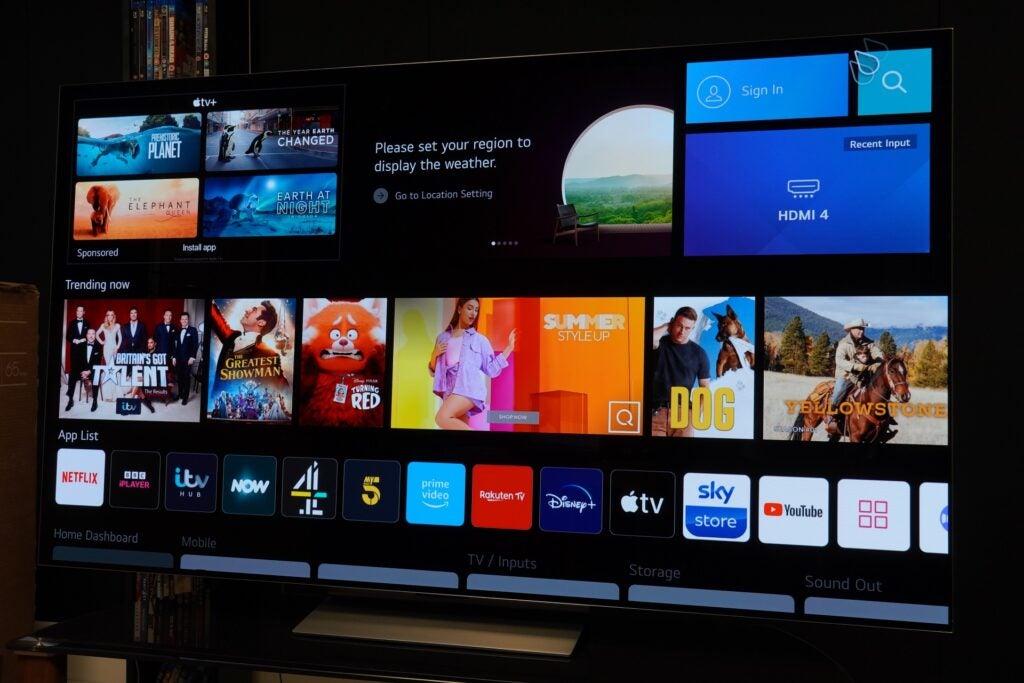
The Menu system is identical, divided into Picture, Sound, General (Settings) and Support. Plus, for those who like to tweak, there are helpful explanations for each setting.
The remote features several hotkey buttons with Netflix, Prime Video, Disney+, Rakuten TV, as well as Google Assistant and Alexa for UK users. It’s a remote that’s comfortable in the hand, with the mouse-like “pointer” easier to control than previous models.
Features
- VRR, ALLM, 4K/120Hz across all HDMI inputs
- Dolby Vision Game mode
- Quick input lag
LG hasn’t shown signs of slowing down on the gaming front, bringing Google Stadia to its complement of cloud gaming services in 2021 and adding Nvidia’s GeForce NOW in 2022.
There’s VRR (Variable Refresh Rate) in the standard HDMI version, alongside Nvidia G-Sync and AMD FreeSync Premium VRR, covering console and PC gamers. Both VRR and Auto Low Latency Mode (ALLM), which automatically puts the TV into its lowest latency, are available across all HDMI inputs, as is 4K/120Hz support.
That means you won’t need to pick and choose which sources to plug into the HDMI inputs, especially if you’re considering adding an eARC-compatible soundbar to this model.
The G2 also adopts the HGiG standard of best practice methods for HDR tone-mapping with games. The Dolby Vision Game mode offers improved picture fidelity, contrast and 4K/120Hz support with compatible games.
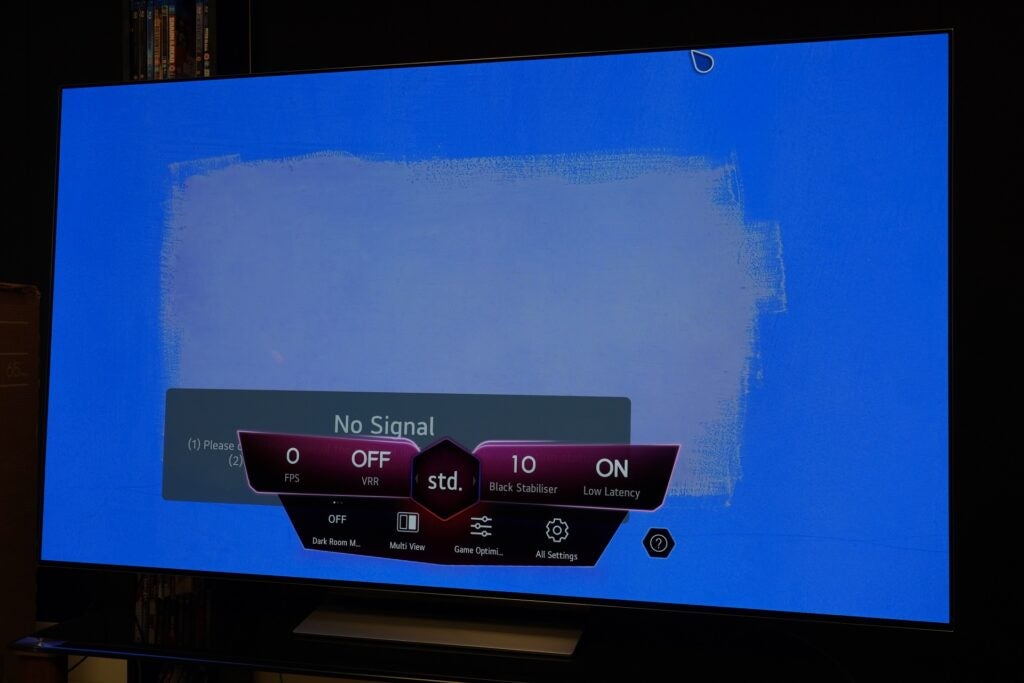
The Game Optimiser pop-up menu has been tweaked with settings for calibrating in a dark room. Game Boost reduces latency to 9.6ms with 60Hz content, and in normal settings I measured latency at 12.9ms at 1080p/4K, which is the same as the C2 OLED.
Four HDMI 2.1 inputs (at 48Gbps bandwidth), a headphone out, digital optical out, Ethernet socket, satellite and aerial inputs, three USB, and a CI+ 1.4 (Common Interface) slot make up the physical connections. HDMI 2 is designated eARC for pass-through of higher-quality soundtracks such as Dolby Atmos to a compatible soundbar.
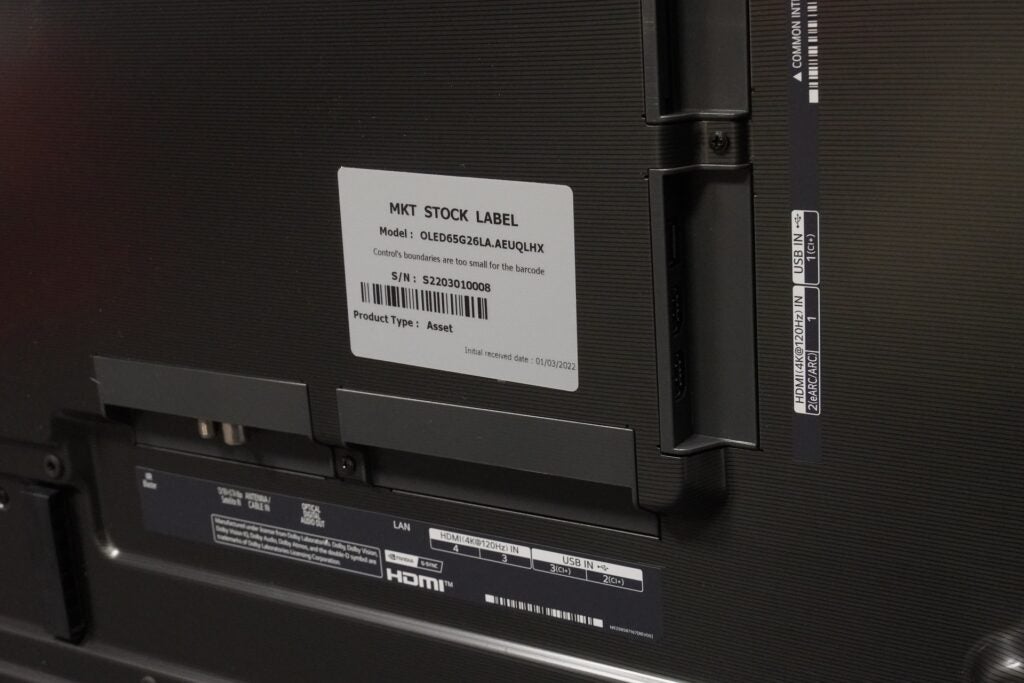
On the wireless front there’s Wi-Fi, Bluetooth 5.0, AirPlay 2, Chromecast, WiSA (Wireless Speaker & Audio) and Bluetooth Surround Ready.
Smart assistants are catered for by Amazon Alexa, Google Assistant as well as LG’s ThinQ service, which is handy to call upon when searching for content across services.
There are no new features to manage burn-in and image retention, which you can read more about here. LG uses Pixel Cleaning (which checks and adjusts each pixel), Screen Move (which slightly shifts the entire image), and Logo Brightness (automatically reduces the brightness of logo and subtitles) to limit retention.
Picture Quality
- Fabulously bright HDR images
- Improved motion
- Impressive upscaling
LG added its brighter OLED Evo technology to its C1 and G1 models, and the C2 and G2 display further gains with the new OLED EX panels, which use a different material in their construction (Deuterium, in case you were wondering).
The G2 ekes out 10% more brightness over the C2 with the Brightness Booster Max tech, so there’s no parity in picture terms. I measured brightness on a 10% HDR window at 1012 nits, which betters the C2’s 854. In clearing 1000 nits, the need for tone mapping with HDR10 content is lessened, which should allow the G2 to display 1000-nit mastered HDR10 content in better fashion.
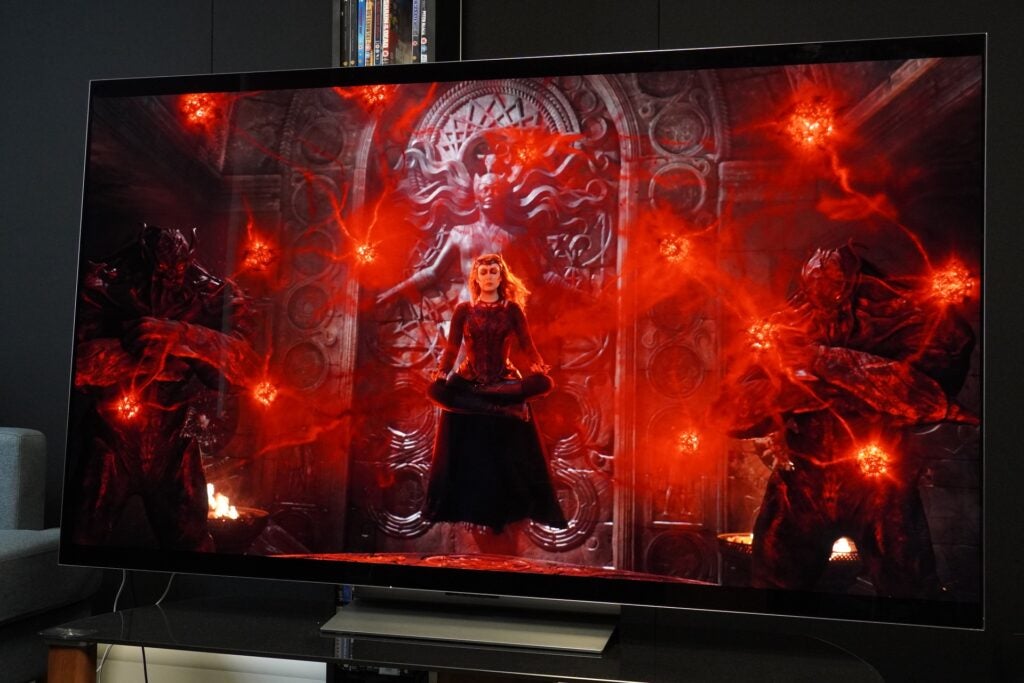
Along with HDR10 and HLG (there’s no HDR10+), there’s Dolby Vision IQ with Precision Detail. IQ uses the TV’s light sensor to adapt colour, contrast and luminance to optimise the image for brightly lit or dark rooms. The Precision Detail part aims to reveal more detail in the brightest and darkest part of the picture, while also emphasising contrast better.
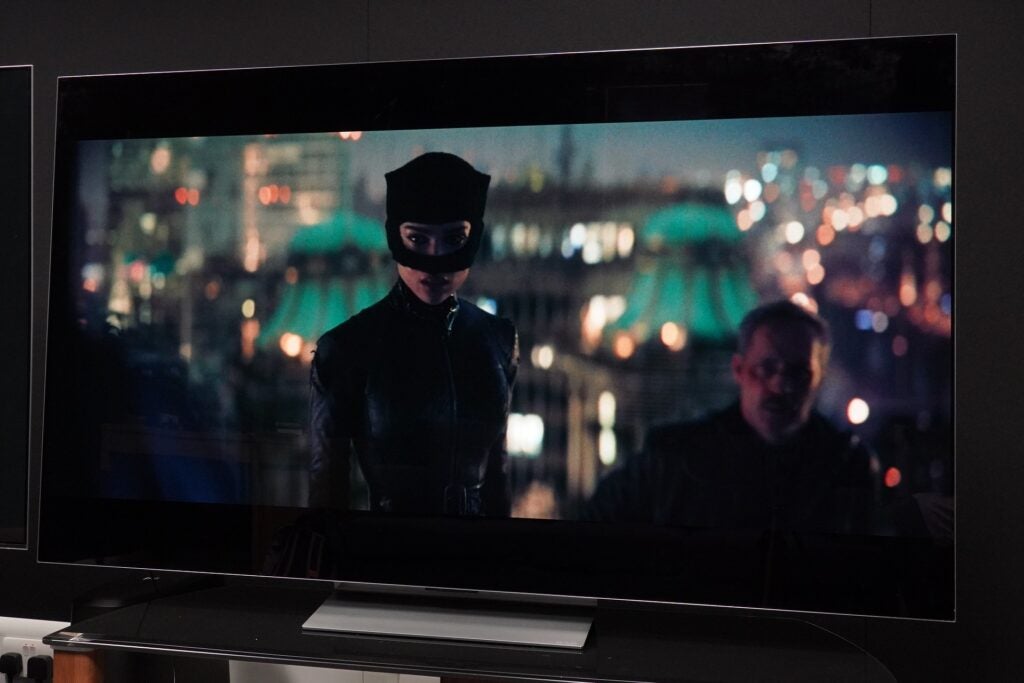
And so, with Dolby Vision IQ and a 4K Blu-ray of The Batman, the LG produces a deliciously textured image, wringing out lots of detail from the film’s gothic sets and character costuming.
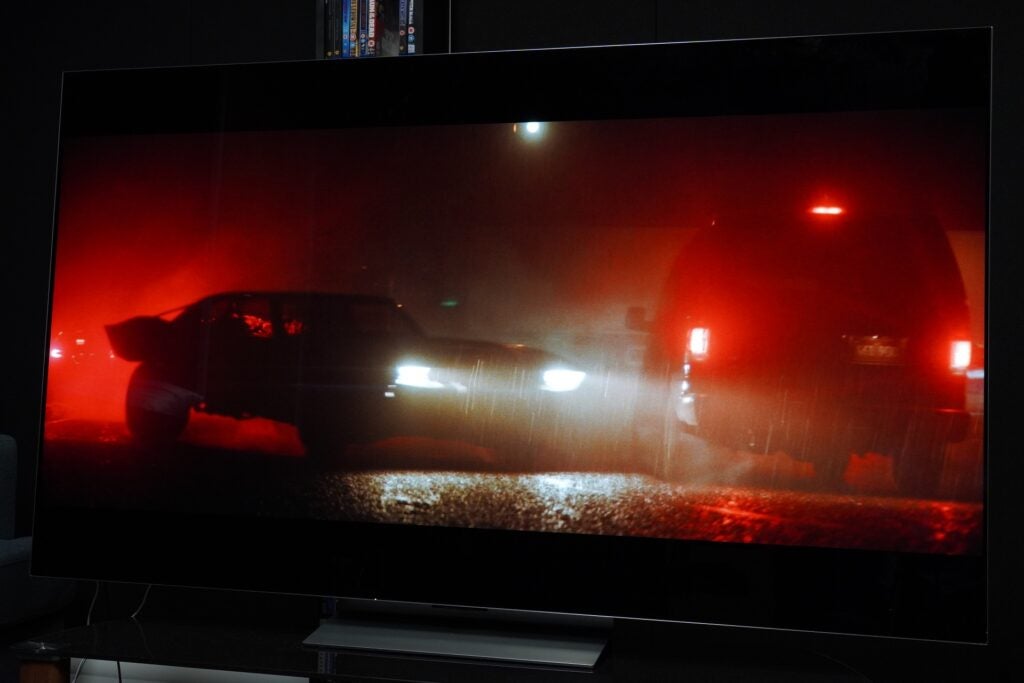
Headlights of cars and motorcycles burn bright when cast against the blacks of Greig Fraser’s cinematography, creating an image of great depth and three-dimensionality with its intense HDR highlights. The burnt-orange reds of Gotham’s sky are impressively conveyed, and while The Batman doesn’t have the most varied colour palette, blacks are inky, white tones are bright, and when colour pops – as it does with the red torch in the finale – it’s with impressive intensity.
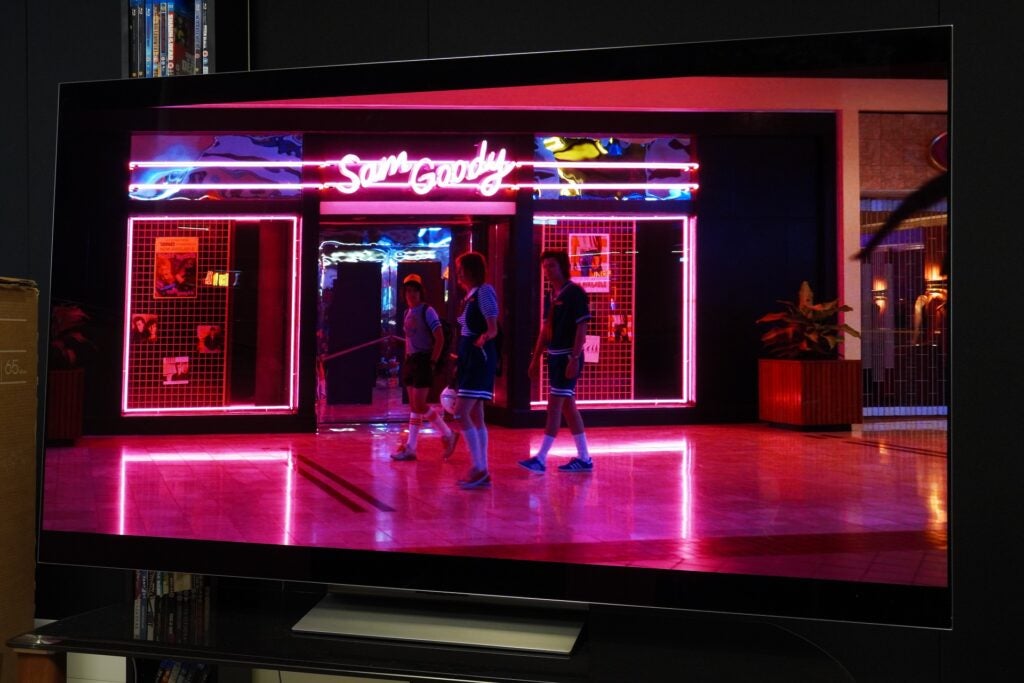
It’s a similar case with season three of Stranger Things. The 80s’ Day Glo colours are memorably conveyed, with neon pink signage in the shopping mall popping off the screen, while in The Dig there’s more perceptible detail in night-time scenes, although it does give way to some raised-looking blacks from time to time. For the most part, the way in which the G2 deals with low level dark detail impresses.
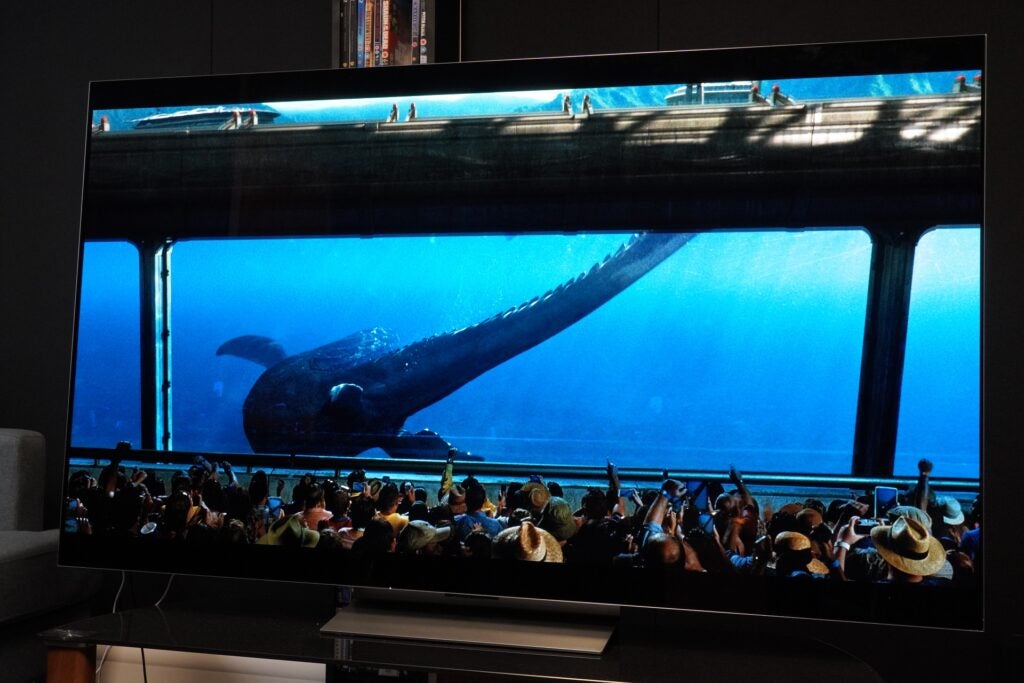
HDR10 and HLG content looks fabulous, the increased brightness producing a slightly bolder sense of contrast than I remember with the G1 showing Jurassic World (in Filmmaker mode). The colour tuning hasn’t changed much, if at all, from the G1; its appearance is fantastically lush and punchy (the blues of the water tank look fantastic), but it maintains a naturalism that applies to complexions as well. With Ridley Road (iPlayer), the colours of the 60s’ set production are held up as rich and vibrant – the G2’s HDR performance is gorgeous.
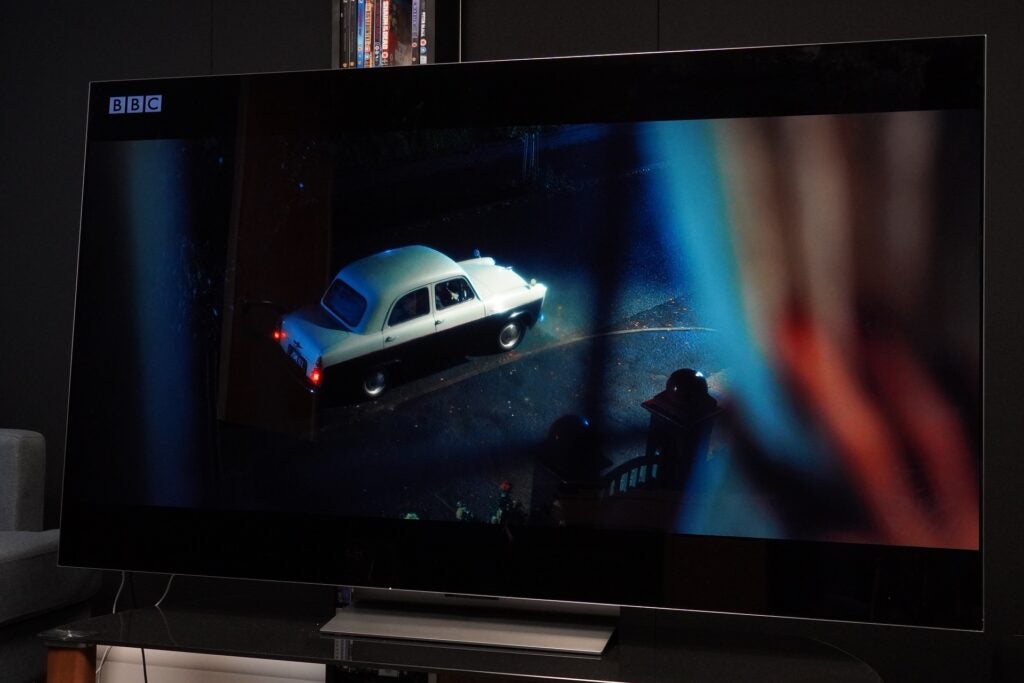
Its SDR (standard dynamic range) performance is worthy of kudos, with a colourful and bright presentation in The Big Bang Theory. Black levels are strong and deep, while primary and secondary colours have a pleasingly saturated and expressive look to them.

With the α9 Gen 5 AI processor in play, upscaling of lower than 4K sources is strong. Detail is excellent with HD sources; the G2 brings out the fine nylon fabric detail of Dion Dublin’s jacket in Homes Under The Hammer, as well as the texture and look of various antiques in Antiques Road Trip with great fidelity. Complexions remain varied and natural across any programme I watched, although there are times where facial features look soft rather than defined – it’s really more of a quibble.
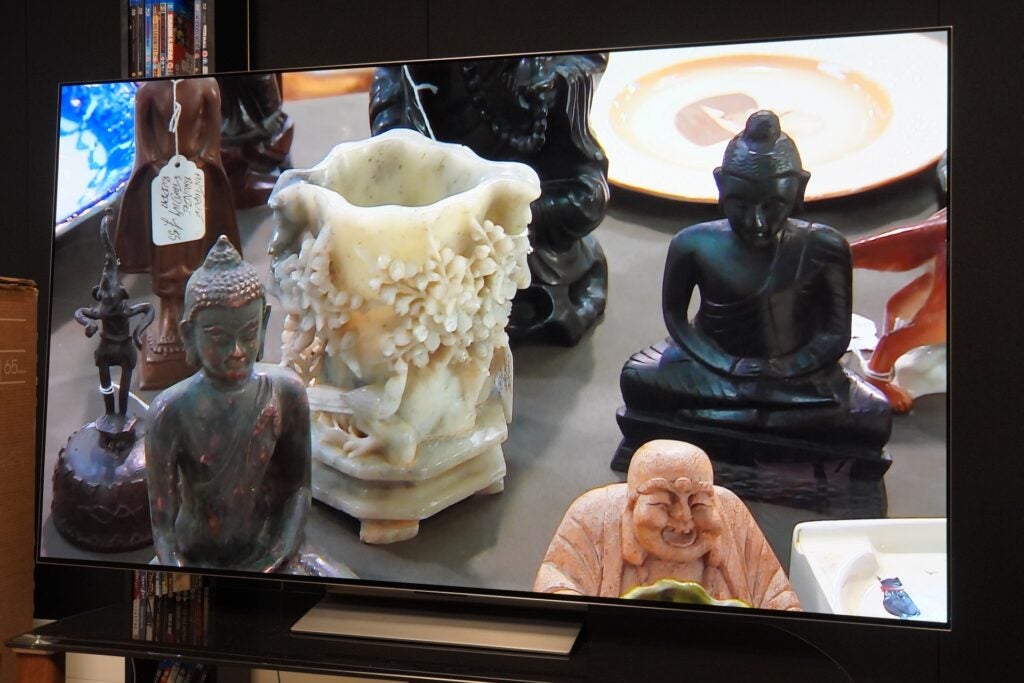
Drop down to standard definition and praise is, of course, more qualified; but the G2 does well with what it’s given. Edge definition of objects isn’t the strongest, a segment during Jeremy Vine reveals jagged edges to a monitor screen, and while sharpness and detail levels drop, colours are portrayed in a convincing manner.
Motion is an area where LG has made significant strides forward. There are fewer noticeable stutters or judder, with greater stability and consistency watching 1917 on 4K Blu-ray. The scene where Lance Corporal Schofield runs across the field is more naturally resolved, and while it isn’t at the level of Sony’s motion processing, it’s conceivably on par with Panasonic.
Sound Quality
- Atmos is a little too polite
- Better with non-Atmos content
- Can’t pass-through DTS tracks
As good as the images are, the sound is merely competent. The G2 lacks the punchiness of Sony’s Acoustic Surface Audio technology or the sharpness of Samsung’s Object Tracking Sound.
With Dolby Atmos activated, the G2 produces a slightly bigger presence and weight to its performance than without, voices delivered with clarity and solid tracking of effects as they pan across the screen.
However, there’s a lack of intensity about the whole performance. The chase scene in The Batman loses much of its power and dynamism, the roar of the muscle car-inspired Batmobile diminished. And despite Atmos, there’s no impression of height or width that extends beyond the TV’s frame.
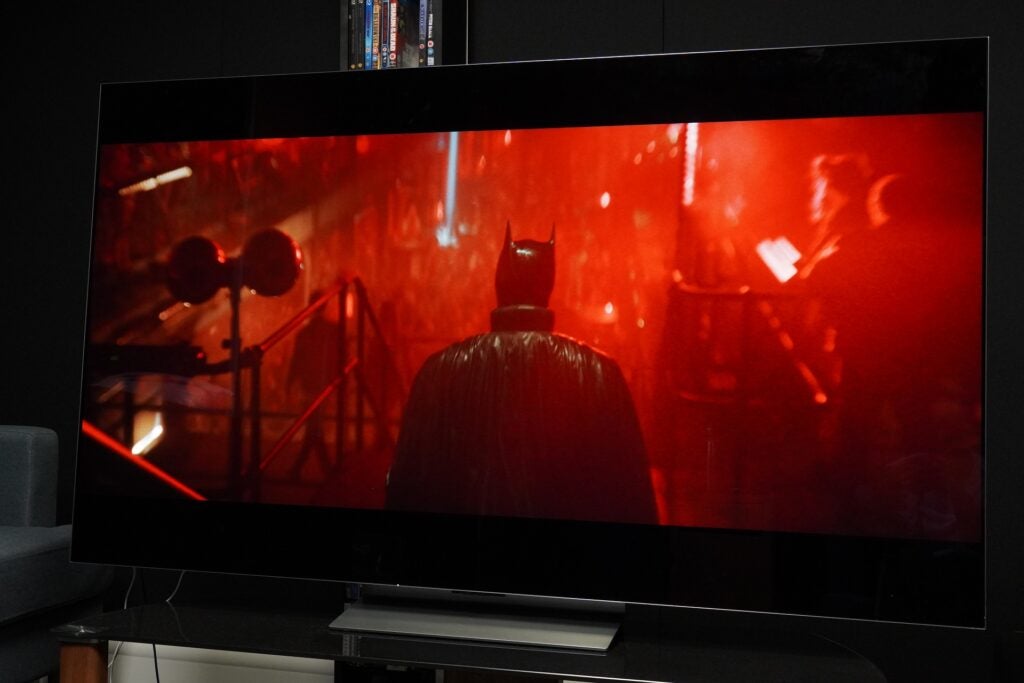
Bass Boost makes little difference to the apparently “thumping” nightclub soundtrack as Batman enters the Iceberg club. The balance of the G2’s speakers skew towards the music in the club and not the action on-screen, leaving the fight between Batman and Penguin’s sounding tame.
Ironically, the TV sounds better with non-Dolby Atmos soundtracks; Jurassic World sounds louder and more dynamic. However, the LG G2 can’t pass through DTS soundtracks to a compatible soundbar, converting to PCM when a Polk MagniFi Mini is connected.
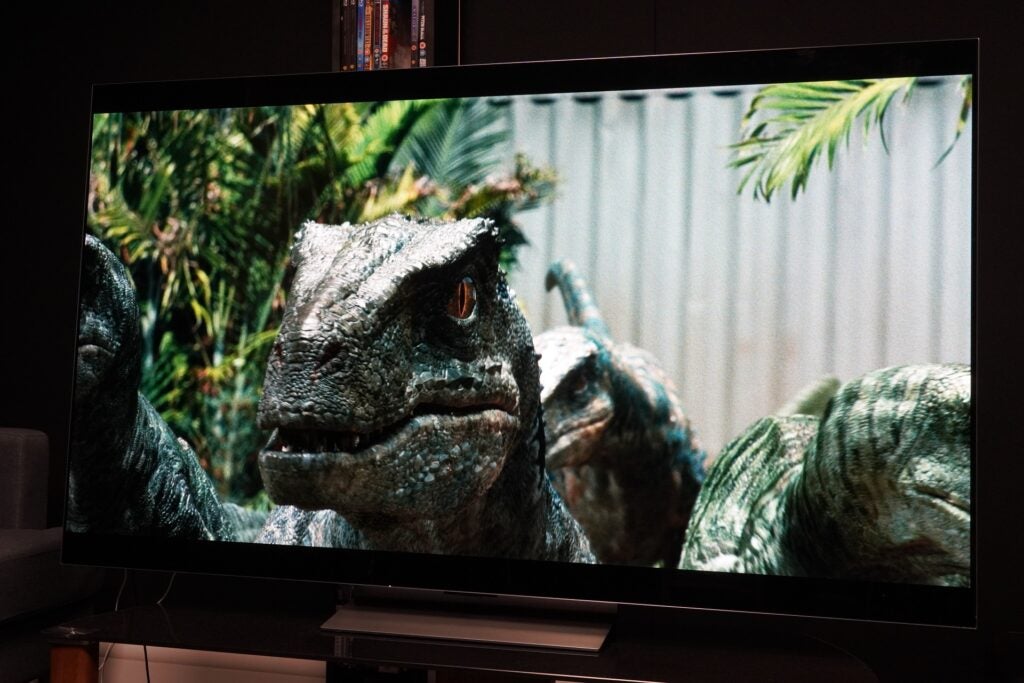
There are several audio modes to choose from, but I’d recommend Standard (for daytime TV) and Cinema (for films) over AI Sound Pro. Sound Pro helps with Atmos, but with other content it unnaturally amplifies sounds in the foreground and background. It’s less sibilant than the 2021 models, although there are a few traces – Standard mode is more natural and smoother, although there’s an element of sibilance there, too.
I’d recommend a soundbar, and LG has one tailored for the G2 in the wall-mounted GX. Other avenues include WiSA 5.1 support, wireless Atmos – if you don’t want cables – and the Bluetooth Surround Ready feature for adding a pair of LG Bluetooth speakers.
Latest deals
Should you buy it?
For a fabulous HDR performance Hitting just over 1000 nits, the G2 puts delivers a terrific HDR performance, with intense highlights and typically excellent contrast. Overall picture quality is impressive from any source and at most resolutions.
If you’re not wall-mounting If you’re not looking to wall mount, then we’d recommend paying less for the LG C2. Its picture performance isn’t as good, but you’ll save yourself plenty of cash.
Final Thoughts
LG has turned out another fantastic TV with the G2 OLED. It’s expensive, costing more than the G1; but as a representation of what OLED can do, this is one of the finer efforts. Its HDR performance is fabulously bright and colourful, its gaming performance is excellent, with a comprehensive set of smarts and build quality that’s sensationally minimalist.
The G2’s audio performance is average, so I’d recommend budgeting for a soundbar or sound system if you don’t have one. And since it’s primarily designed for wall-mounting, you’ll need to purchase a stand if you’re not intending to hand it on a wall, which will again add to the cost.
How we test
We test every televisions we review thoroughly over an extended period of time. We use industry standard tests to compare features properly. We’ll always tell you what we find. We never, ever, accept money to review a product.
Find out more about how we test in our ethics policy.
Tested with real world use
FAQs
The G2 comes with wall brackets as standard. To watch it in a different orientation, you’ll need to purchase either the Swivel Stand or free-standing Gallery Stand. The Gallery Stand only works with 55- and 65-inch models.
In our tests, the LG G2 OLED reached 1012 nits in Standard mode on a 10% HDR window.
Sustainability
Trusted Reviews’ holds the fact that global warming is not a myth as a core value and will continuously endeavour to help protect our planet from harm in its business practices.
As part of this mission, whenever we review a product we send the company a series of questions to help us gauge and make transparent the impact the device has on the environment.
We currently haven’t received answers to the questions on this product, but will update this page the moment we do. You can see a detailed breakdown of the questions we ask and why in our sustainability info page.
Jargon buster
Dolby Atmos
Dolby Atmos is an object-based audio format. It expands on 5.1 and 7.1 soundtracks by adding overhead channels. Sounds are referred to as “audio objects”, of which there can be up to 128 audio channels, and these ‘objects’ can be accurately positioned within a 3D soundscape. This allows soundtracks that support the technology to place sounds above and around the listener with compatible kit.
OLED
Organic Light Emitting Diode is panel technology that allows each individual pixel to produce light rather than relying on a backlight. This enables the screen to accurately display blacks by turning off the pixel, resulting in improved contrast compared to conventional LCD panels.
Dolby Vision IQ
Dolby Vision IQ is an advanced version of the standard Dolby Vision signal. It uses the metadata within its own HDR signal in conjunction with a TV’s light sensor to detect how bright or how dark a room is in order to optimise the picture quality so content retains consistent luminance (brightness) and detail no matter how bright or dark the room is.
Verdict
The G2 is LG’s best OLED, with improvements to its brightness reaping dividends by way of a fantastic HDR performance. Its feature set is extensive, its smart abilities are well implemented; but the cost and focus on wall-mounting mean the C2 OLED is likely to be the more affordable option for most.
Pros
- Excellent HDR performance
- Improved motion skills
- Accommodating gaming features
- Slim design
- Wide selection of streaming apps
Cons
- Higher starting price than G1
- Average audio
- Stand is optional extra
-
ScreenFeatures LG’s new OLED EX panel and Brightness Booster Max technology -
HDRDolby Vision IQ with Precision Detail for exacting Dolby Vision HDR performance
Introduction
OLED has had plenty of detractors, none more so than Samsung. So, there must have been a wry smile across the faces of many at LG when the company’s South Korean adversary launched a QD-OLED rival.
Greater competition hasn’t put LG off its stride, though. The G2 (OLED65G2) is the brand’s top-of-the-line OLED TV, offering improved brightness over the 2021 G1.
LG has been OLED’s biggest cheerleader and the G2 sets out its stall as not just the best 4K TV you can get from the company itself, but potentially the best 4K TV from any manufacturer out there.
Availability
- UKRRP: £3299
- USARRP: $3199
- EuropeRRP: €3599
- CanadaRRP: CA$4999
- AustraliaRRP: AU$5376
The LG G2 OLED model tested is the 65-inch model (OLED65G26LA). It’s also available in a smaller 55-inch model (OLED55G26LA / £2399), a 77-inch (OLED77G26LA / £4499), and the new 83-inch version (OLED83G26LA / £6499).
The 65-inch’s RRP is £3299 / $3199 / €3599 / CA$4999 / AUD$5376. In most markets, the G2’s price has gone up slightly.
Design
- Another elegant, minimalist set
- Wall bracket included as standard
- Stands are optional extras
Like previous Gallery Series OLEDs, the G2 is designed first and foremost with wall-mounting in mind, including wall brackets in the box but no stand.

Aesthetically, it’s an elegant and minimalist effort, with the bezel more of frame that encases the screen. The covers for the back panel look slightly less flimsy when applied than they did on the G1, but it isn’t something you’re going to notice once the TV is set up.
The 65-inch G2 is slightly thicker than the G1 (24.3mm compared to 19.9mm). However, the shallow depth of the rear panel allows it to lie almost flush against a wall, while downward and side-facing connections make it easier to plug in devices.

There’s the option of purchasing the Gallery Stand (if you’re putting the TV in a freestanding position) or Swivel Stand, which tilts at an angle of four degrees. The Swivel Stand is easy enough to lock in, featuring an area to thread through cables to keep the setup neat and tidy. With the G2, LG has designed a TV that works in virtually every position it finds itself.
Interface
- Comprehensive SVOD selection
- No major changes to remote/webOS
The webOS interface and remote continue as is from 2021. The top area of the homescreen has been rejigged with the most recent input added (potentially to make you notice the LG Account sign-up area).
Beneath that is the Trending Now bar, app list, a row of physical/digital inputs and smart connections, live TV and Now Streaming; the latter collates content from iPlayer, Apple TV, All 4, YouTube, Rakuten TV and ITV Hub. I prefer this approach over 2021’s webOS, since it’s more focused instead of serving content from every app, which I found overwhelming.
There’s a big number of apps, with the UK catch-up and on-demand apps (along with Freeview Play), Sky Store and Now included alongside the usual big-hitters of Netflix, Disney+, Prime Video, Spotify, Apple TV. US buyers benefit from Hulu and HBO Max, too.

The Menu system is identical, divided into Picture, Sound, General (Settings) and Support. Plus, for those who like to tweak, there are helpful explanations for each setting.
The remote features several hotkey buttons with Netflix, Prime Video, Disney+, Rakuten TV, as well as Google Assistant and Alexa for UK users. It’s a remote that’s comfortable in the hand, with the mouse-like “pointer” easier to control than previous models.
Features
- VRR, ALLM, 4K/120Hz across all HDMI inputs
- Dolby Vision Game mode
- Quick input lag
LG hasn’t shown signs of slowing down on the gaming front, bringing Google Stadia to its complement of cloud gaming services in 2021 and adding Nvidia’s GeForce NOW in 2022.
There’s VRR (Variable Refresh Rate) in the standard HDMI version, alongside Nvidia G-Sync and AMD FreeSync Premium VRR, covering console and PC gamers. Both VRR and Auto Low Latency Mode (ALLM), which automatically puts the TV into its lowest latency, are available across all HDMI inputs, as is 4K/120Hz support.
That means you won’t need to pick and choose which sources to plug into the HDMI inputs, especially if you’re considering adding an eARC-compatible soundbar to this model.
The G2 also adopts the HGiG standard of best practice methods for HDR tone-mapping with games. The Dolby Vision Game mode offers improved picture fidelity, contrast and 4K/120Hz support with compatible games.

The Game Optimiser pop-up menu has been tweaked with settings for calibrating in a dark room. Game Boost reduces latency to 9.6ms with 60Hz content, and in normal settings I measured latency at 12.9ms at 1080p/4K, which is the same as the C2 OLED.
Four HDMI 2.1 inputs (at 48Gbps bandwidth), a headphone out, digital optical out, Ethernet socket, satellite and aerial inputs, three USB, and a CI+ 1.4 (Common Interface) slot make up the physical connections. HDMI 2 is designated eARC for pass-through of higher-quality soundtracks such as Dolby Atmos to a compatible soundbar.

On the wireless front there’s Wi-Fi, Bluetooth 5.0, AirPlay 2, Chromecast, WiSA (Wireless Speaker & Audio) and Bluetooth Surround Ready.
Smart assistants are catered for by Amazon Alexa, Google Assistant as well as LG’s ThinQ service, which is handy to call upon when searching for content across services.
There are no new features to manage burn-in and image retention, which you can read more about here. LG uses Pixel Cleaning (which checks and adjusts each pixel), Screen Move (which slightly shifts the entire image), and Logo Brightness (automatically reduces the brightness of logo and subtitles) to limit retention.
Picture Quality
- Fabulously bright HDR images
- Improved motion
- Impressive upscaling
LG added its brighter OLED Evo technology to its C1 and G1 models, and the C2 and G2 display further gains with the new OLED EX panels, which use a different material in their construction (Deuterium, in case you were wondering).
The G2 ekes out 10% more brightness over the C2 with the Brightness Booster Max tech, so there’s no parity in picture terms. I measured brightness on a 10% HDR window at 1012 nits, which betters the C2’s 854. In clearing 1000 nits, the need for tone mapping with HDR10 content is lessened, which should allow the G2 to display 1000-nit mastered HDR10 content in better fashion.

Along with HDR10 and HLG (there’s no HDR10+), there’s Dolby Vision IQ with Precision Detail. IQ uses the TV’s light sensor to adapt colour, contrast and luminance to optimise the image for brightly lit or dark rooms. The Precision Detail part aims to reveal more detail in the brightest and darkest part of the picture, while also emphasising contrast better.

And so, with Dolby Vision IQ and a 4K Blu-ray of The Batman, the LG produces a deliciously textured image, wringing out lots of detail from the film’s gothic sets and character costuming.

Headlights of cars and motorcycles burn bright when cast against the blacks of Greig Fraser’s cinematography, creating an image of great depth and three-dimensionality with its intense HDR highlights. The burnt-orange reds of Gotham’s sky are impressively conveyed, and while The Batman doesn’t have the most varied colour palette, blacks are inky, white tones are bright, and when colour pops – as it does with the red torch in the finale – it’s with impressive intensity.

It’s a similar case with season three of Stranger Things. The 80s’ Day Glo colours are memorably conveyed, with neon pink signage in the shopping mall popping off the screen, while in The Dig there’s more perceptible detail in night-time scenes, although it does give way to some raised-looking blacks from time to time. For the most part, the way in which the G2 deals with low level dark detail impresses.

HDR10 and HLG content looks fabulous, the increased brightness producing a slightly bolder sense of contrast than I remember with the G1 showing Jurassic World (in Filmmaker mode). The colour tuning hasn’t changed much, if at all, from the G1; its appearance is fantastically lush and punchy (the blues of the water tank look fantastic), but it maintains a naturalism that applies to complexions as well. With Ridley Road (iPlayer), the colours of the 60s’ set production are held up as rich and vibrant – the G2’s HDR performance is gorgeous.

Its SDR (standard dynamic range) performance is worthy of kudos, with a colourful and bright presentation in The Big Bang Theory. Black levels are strong and deep, while primary and secondary colours have a pleasingly saturated and expressive look to them.

With the α9 Gen 5 AI processor in play, upscaling of lower than 4K sources is strong. Detail is excellent with HD sources; the G2 brings out the fine nylon fabric detail of Dion Dublin’s jacket in Homes Under The Hammer, as well as the texture and look of various antiques in Antiques Road Trip with great fidelity. Complexions remain varied and natural across any programme I watched, although there are times where facial features look soft rather than defined – it’s really more of a quibble.

Drop down to standard definition and praise is, of course, more qualified; but the G2 does well with what it’s given. Edge definition of objects isn’t the strongest, a segment during Jeremy Vine reveals jagged edges to a monitor screen, and while sharpness and detail levels drop, colours are portrayed in a convincing manner.
Motion is an area where LG has made significant strides forward. There are fewer noticeable stutters or judder, with greater stability and consistency watching 1917 on 4K Blu-ray. The scene where Lance Corporal Schofield runs across the field is more naturally resolved, and while it isn’t at the level of Sony’s motion processing, it’s conceivably on par with Panasonic.
Sound Quality
- Atmos is a little too polite
- Better with non-Atmos content
- Can’t pass-through DTS tracks
As good as the images are, the sound is merely competent. The G2 lacks the punchiness of Sony’s Acoustic Surface Audio technology or the sharpness of Samsung’s Object Tracking Sound.
With Dolby Atmos activated, the G2 produces a slightly bigger presence and weight to its performance than without, voices delivered with clarity and solid tracking of effects as they pan across the screen.
However, there’s a lack of intensity about the whole performance. The chase scene in The Batman loses much of its power and dynamism, the roar of the muscle car-inspired Batmobile diminished. And despite Atmos, there’s no impression of height or width that extends beyond the TV’s frame.

Bass Boost makes little difference to the apparently “thumping” nightclub soundtrack as Batman enters the Iceberg club. The balance of the G2’s speakers skew towards the music in the club and not the action on-screen, leaving the fight between Batman and Penguin’s sounding tame.
Ironically, the TV sounds better with non-Dolby Atmos soundtracks; Jurassic World sounds louder and more dynamic. However, the LG G2 can’t pass through DTS soundtracks to a compatible soundbar, converting to PCM when a Polk MagniFi Mini is connected.

There are several audio modes to choose from, but I’d recommend Standard (for daytime TV) and Cinema (for films) over AI Sound Pro. Sound Pro helps with Atmos, but with other content it unnaturally amplifies sounds in the foreground and background. It’s less sibilant than the 2021 models, although there are a few traces – Standard mode is more natural and smoother, although there’s an element of sibilance there, too.
I’d recommend a soundbar, and LG has one tailored for the G2 in the wall-mounted GX. Other avenues include WiSA 5.1 support, wireless Atmos – if you don’t want cables – and the Bluetooth Surround Ready feature for adding a pair of LG Bluetooth speakers.
Latest deals
Should you buy it?
For a fabulous HDR performance Hitting just over 1000 nits, the G2 puts delivers a terrific HDR performance, with intense highlights and typically excellent contrast. Overall picture quality is impressive from any source and at most resolutions.
If you’re not wall-mounting If you’re not looking to wall mount, then we’d recommend paying less for the LG C2. Its picture performance isn’t as good, but you’ll save yourself plenty of cash.
Final Thoughts
LG has turned out another fantastic TV with the G2 OLED. It’s expensive, costing more than the G1; but as a representation of what OLED can do, this is one of the finer efforts. Its HDR performance is fabulously bright and colourful, its gaming performance is excellent, with a comprehensive set of smarts and build quality that’s sensationally minimalist.
The G2’s audio performance is average, so I’d recommend budgeting for a soundbar or sound system if you don’t have one. And since it’s primarily designed for wall-mounting, you’ll need to purchase a stand if you’re not intending to hand it on a wall, which will again add to the cost.
How we test
We test every televisions we review thoroughly over an extended period of time. We use industry standard tests to compare features properly. We’ll always tell you what we find. We never, ever, accept money to review a product.
Find out more about how we test in our ethics policy.
Tested with real world use
FAQs
The G2 comes with wall brackets as standard. To watch it in a different orientation, you’ll need to purchase either the Swivel Stand or free-standing Gallery Stand. The Gallery Stand only works with 55- and 65-inch models.
In our tests, the LG G2 OLED reached 1012 nits in Standard mode on a 10% HDR window.
Sustainability
Trusted Reviews’ holds the fact that global warming is not a myth as a core value and will continuously endeavour to help protect our planet from harm in its business practices.
As part of this mission, whenever we review a product we send the company a series of questions to help us gauge and make transparent the impact the device has on the environment.
We currently haven’t received answers to the questions on this product, but will update this page the moment we do. You can see a detailed breakdown of the questions we ask and why in our sustainability info page.
Jargon buster
Dolby Atmos
Dolby Atmos is an object-based audio format. It expands on 5.1 and 7.1 soundtracks by adding overhead channels. Sounds are referred to as “audio objects”, of which there can be up to 128 audio channels, and these ‘objects’ can be accurately positioned within a 3D soundscape. This allows soundtracks that support the technology to place sounds above and around the listener with compatible kit.
OLED
Organic Light Emitting Diode is panel technology that allows each individual pixel to produce light rather than relying on a backlight. This enables the screen to accurately display blacks by turning off the pixel, resulting in improved contrast compared to conventional LCD panels.
Dolby Vision IQ
Dolby Vision IQ is an advanced version of the standard Dolby Vision signal. It uses the metadata within its own HDR signal in conjunction with a TV’s light sensor to detect how bright or how dark a room is in order to optimise the picture quality so content retains consistent luminance (brightness) and detail no matter how bright or dark the room is.


















